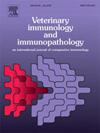荷斯坦奶牛肝脏和瘤胃吸虫感染、乳体细胞及toll样受体5基因和维生素D代谢相关基因多态性的关系
IF 1.4
3区 农林科学
Q4 IMMUNOLOGY
引用次数: 0
摘要
本研究研究了荷斯坦奶牛CYP3A4、CYP2R1和TLR5基因多态性及其与肝吸虫(片形吸虫)和瘤胃吸虫(Calicophoron / Paramphistomum spp.)感染的关系,以及与乳体细胞计数(SCC)作为乳腺炎指标的关系。对24头奶牛的基因外显子、5′-、3′-非翻译区(UTR)、内含子和侧翼区进行DNA测序,发现442个变异(388个snp和54个InDels),其中116个是以前未知的变异。我们检测到三个新的非同义变异导致衍生的氨基酸交换,即CYP3A4 p.Gly197Ser, CYP3A4 p.Ile388Val和CYP2R1 p.Val11Ala。新发现的SNP 25:36589922 T >; C (ss11846100002)位于CYP3A4的剪接位点,但对剪接酶的结合评分没有影响。CYP2R1和TLR5基因在5 ' -和3 ' - utr中存在11个snp,部分影响转录因子结合位点或microRNA靶位点。通过(广义)线性混合模型分析多态性和构建的单倍型与感染性状之间的关系,包括进一步的潜在混杂因素。总共有109个CYP3A4变异、37个CYP2R1变异和18个TLR5变异与肝F.和瘤胃吸虫感染以及SCC显著相关。CYP2R1和TLR5变异主要与SCC有关,表明这些基因在细菌感染的免疫反应中发挥作用。单倍型分析显示特异性CYP3A4单倍型与肝螺旋体蠕虫数量和粪卵数量有显著相关性。这项研究揭示了与维生素D代谢和免疫反应相关的基因多态性的重要见解,这些基因多态性似乎在蠕虫和乳房感染中发挥作用。本文章由计算机程序翻译,如有差异,请以英文原文为准。
Relationships between liver and rumen fluke infections, milk somatic cells and polymorphisms in the Toll-like receptor 5 gene and vitamin D metabolism-related genes in Holstein dairy cows
This study investigated polymorphisms in the genes CYP3A4, CYP2R1, and TLR5, and their associations with liver fluke (Fasciola hepatica) and rumen fluke (Calicophoron / Paramphistomum spp.) infections as well as with milk somatic cell count (SCC) as an indicator for mastitis in Holstein Friesian dairy cows. DNA sequencing of the genes’ exons, 5′-, 3′-untranslated regions (UTR), introns, and flanking regions of 24 cows revealed 442 variants (388 SNPs and 54 InDels) including 116 previously unknown variants. We detected three novel non-synonymous variants leading to the derived amino acid exchanges, i.e. CYP3A4 p.Gly197Ser, CYP3A4 p.Ile388Val, and CYP2R1 p.Val11Ala. The newly identified SNP 25:36589922 T > C (ss11846100002) is positioned in the splice site of CYP3A4, but showed no impact on the binding score of the splice enzymes. The CYP2R1 and TLR5 genes presented 11 SNPs in the 5′- and 3′-UTR, partly influencing transcription factor binding or microRNA target sites. Associations between polymorphisms and constructed haplotypes with infection traits were analysed via (generalized) linear mixed models including further potential confounders. In total, 109 variants in CYP3A4, 37 variants in CYP2R1, and 18 variants in TLR5 were significantly associated with F. hepatica and rumen fluke infections, and with SCC. The CYP2R1 and TLR5 variants were mostly linked to SCC, indicating the genes’ roles in immune responses to bacterial infections. Haplotype analysis revealed significant associations between specific CYP3A4 haplotypes and F. hepatica worm count and faecal egg counts. This study revealed significant insights into gene polymorphisms related to vitamin D metabolism and immune response, which seem to play a role in helminth and udder infections.
求助全文
通过发布文献求助,成功后即可免费获取论文全文。
去求助
来源期刊
CiteScore
3.40
自引率
5.60%
发文量
79
审稿时长
70 days
期刊介绍:
The journal reports basic, comparative and clinical immunology as they pertain to the animal species designated here: livestock, poultry, and fish species that are major food animals and companion animals such as cats, dogs, horses and camels, and wildlife species that act as reservoirs for food, companion or human infectious diseases, or as models for human disease.
Rodent models of infectious diseases that are of importance in the animal species indicated above,when the disease requires a level of containment that is not readily available for larger animal experimentation (ABSL3), will be considered. Papers on rabbits, lizards, guinea pigs, badgers, armadillos, elephants, antelope, and buffalo will be reviewed if the research advances our fundamental understanding of immunology, or if they act as a reservoir of infectious disease for the primary animal species designated above, or for humans. Manuscripts employing other species will be reviewed if justified as fitting into the categories above.
The following topics are appropriate: biology of cells and mechanisms of the immune system, immunochemistry, immunodeficiencies, immunodiagnosis, immunogenetics, immunopathology, immunology of infectious disease and tumors, immunoprophylaxis including vaccine development and delivery, immunological aspects of pregnancy including passive immunity, autoimmuity, neuroimmunology, and transplanatation immunology. Manuscripts that describe new genes and development of tools such as monoclonal antibodies are also of interest when part of a larger biological study. Studies employing extracts or constituents (plant extracts, feed additives or microbiome) must be sufficiently defined to be reproduced in other laboratories and also provide evidence for possible mechanisms and not simply show an effect on the immune system.

 求助内容:
求助内容: 应助结果提醒方式:
应助结果提醒方式:


